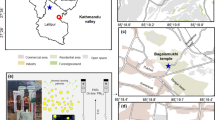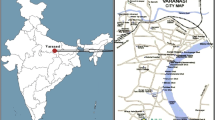Abstract
The effect of firework events on air quality was assessed from ambient fine particulate matter (PM2.5) collected during the Diwali period in two consecutive years, i.e., November 2015 and October 2016. The extensive firework activities led to the short-term degradation of air quality during the Diwali days. PM2.5 samples were chemically characterised for elements, water-soluble ionic species, organic carbon (OC) and elemental carbon (EC). Ba, K, Sr, S, Mg and Na showed significant increases in concentration on Diwali days compared to pre-Diwali days which revealed their association with firecrackers. Concentration of SO42−, NO3−, Cl−, K+ and NH4+ ions contributed to the increases in PM2.5 concentration on Diwali days. Higher OC/EC ratios indicated the formation of secondary organic carbon during the Diwali period. This study concludes that the high PM2.5 level during Diwali 2016 was a result of contribution from fireworks on the Diwali night, trans-regional movement of pollutants due to crop residue burning, low wind speed (0.15 m s−1), and high humidity. It was observed that short-term exposure to Diwali is plausible to generate 1.3% increase in non-carcinogenic hazard index due to elements Al and Ba during Diwali 2016, whereas no significant variation was observed for the carcinogenic risk due to Pb. However, in 2015, the increase in non-carcinogenic hazard index was appreciably lower as compared to 2016.







Similar content being viewed by others

Abbreviations
- NOAA:
-
National Oceanic and Atmospheric Administration
- READY:
-
Real-time Environmental Applications and Display System
- USEPA:
-
United States Environmental Protection Agency
- IMPROVE:
-
Interagency Monitoring of Protected Visual Environment
- CPCB:
-
Central Pollution Control Board
- NASA:
-
National Aeronautics and Space Administration
- UTC:
-
Universal Time Coordinated
- TSP:
-
Total suspended particulate
- ITO:
-
Income Tax Office
References
Attri AK, Kumar U, Jain VK et al (2001) Formation of ozone by fireworks. Nature 411:1015
Barman SC, Singh R, Negi MPS et al (2008) Ambient air quality of Lucknow City (India) during use of fireworks on Diwali festival. Environ Monit Assess 137:495–504
Census of India (2011) http://censusindia.gov.in/2011-prov-results/provdata_productsdelhi.html. Accessed June 2017
Central Pollution Control Board Delhi (2016) Deepawali Monitoring Report
Chatterjee A, Sarkar C, Adak A et al (2013) Ambient air quality during Diwali festival over Kolkata—a mega—city in India. Aerosol Air Qual Res 13(13):1133–1144
Curtis L, Rea W, Smith WP et al (2006) Adverse health effects of outdoor air pollutants. Environ Pollut 32(6):815–830
Draxler RR, Rolph GD (2003) HYSPLIT (Hybrid Single–Particle Lagrangian Integrated Trajectory) Model. http://www.arl.noaa.gov/ready/hysplit4.html. Accessed June 2017
Faiz A, Sturm PJ (2000) New directions: air pollution and road traffic in developing countries. Atmos Environ 34(27):4745–4746
Ge X, He Y, Sun Y et al (2017) Characteristics and formation mechanisms of fine particulate nitrate in typical urban areas in China. Atmosphere 8(3):62
George MP, Kaur BJ, Sharma A et al (2013) Delhi smog 2012: cause and concerns. J Pollut Eff Cont 1(1):1–6
Gouder C, Montefort S (2014) Potential impact of fireworks on respiratory health Lung India 31(4):375–379
Gurjar BR, Mohan M (2003) Integrated risk analysis for acute and chronic exposure to toxic chemicals. J Hazard Mater 103(1):25–40
Hindustan Times (2016) Delhi chokes on smoke from neighbouring states. http://www.hindustantimes.com/delhi-news/delhi-chokes-on-smoke-from-neighbouring-states/story-zAkXkflle5MoUXLNYfZa0H.html. Accessed June 2017
Hirai K, Yamazaki Y, Okada K et al (2000) Acute eosinophilic pneumonia associated with smoke from fireworks. Intern Med 39:401–403
Huang X, Qiu R, Chan CK et al (2011) Evidence of high PM2.5 strong acidity in ammonia-rich atmosphere of Guangzhou, China: transition in pathways of ambient ammonia to form aerosol ammonium at [NH4 +]/[SO42–] = 1.5. Atmos Res 99:488–495ICMR [(Indian Council of Medical Research) (2005) Foster Development of an Atlas of Cancer in India New Delhi]
Kulshrestha UC, Rao TN, Azhaguvel S et al (2004) Emissions and accumulation of metals in the atmosphere due to crackers and sparkles during Diwali festival in India. Atmos Environ 38:4421–4425
Lim JM, Lee JH, Chung YS et al (2009) Risk assessment of inhalation exposure for airborne toxic metals using instrumental neutron activation analysis. J Radioanal Nucl Chem 281(2):185–188
Lippmann M (2011) Regional deposition of particles in the human respiratory tract. In: Supplement 26 Handbook of Physiology, Reactions to Environmental Agents. Wiley-Blackwell, pp 213–232
Lv Y, Li X, Xu TT et al (2016) Size distributions of polycyclic aromatic hydrocarbons in urban atmosphere: sorption mechanism and source contributions to respiratory deposition. Atmos Chem Phys 16(5):2971–2983
Lyu Y, Zhang K, Chai F et al (2017) Atmospheric size-resolved trace elements in a city affected by non-ferrous metal smelting: indications of respiratory deposition and health risk. Environ Pollut 224:559–571
Moreno T, Querol X, Alastuey A et al (2007) Recreational atmospheric pollution episodes: inhalable metalliferous particles from firework displays. Atmos Environ 41:913–922
NAAQMS 2001 Air Quality in Delhi, NAAQMS/17/2000 (2001) Central Pollution Control Board Parivesh Bhawan Delhi India 1989–2000
NASA (National Aeronautics and Space Administration) (2017) Using satellites to size up the severity of crop fires in northern India. https://earthobservatory.nasa.gov/blogs/earthmatters/2017/02/08/the-crop-residue-fires-in-northern-india-were-the-most-severe-in-more-than-a-decade/. Accessed June 2017
Nishanth T, Praseed KM, Rathnakaran K et al (2012) Atmospheric pollution in a semi-urban, coastal region in India following festival seasons. Atmos Environ 47:295–306
Pandey JS, Kumar R, Devotta S et al (2005) Health risks of NO2, SPM and SO2 in Delhi (India). Atmos Environ 39(36):6868–6874
Parkhi N, Dilip C, Sachin DG et al (2016) Large inter annual variation in air quality during the annual festival Diwali in an Indian megacity. J Environ Sci 43:265–272
Pathak RK, Wu WS, Wang T (2009) Summertime PM2.5 ionic species in four major cities of China: nitrate formation in an ammonia-deficient atmosphere. Atmos Chem Phys 9:1711–1722
Pathak B, Biswas J, Bharali C et al (2014) Short term introduction of pollutants into the atmosphere at a location in the Brahmaputra Basin: a case study. Atmos Pollut Res 6:220–229
Perrino C, Tiwari S, Catrambone M et al (2011) Chemical characterization of atmospheric pm in Delhi, India, during different periods of the year including Diwali festival. Atmos Pollut Res 2:418–427
Perry KD (1999) Effects of outdoor pyrotechnic displays on the regional air quality of western Washington state. J Air Waste Manag Assoc 49:146–155
Pervez S, Rajan KC, Shippi D et al (2016) Chemical speciation of aerosols and air quality degradation during the festival of lights (Diwali). Atmos Pollut Res 7:92–99
Pope CA III, Dockery DW (2006) Health effects of fine particulate air pollution: lines that connect. J Air Waste Manag Assoc 56:709–742
Ravindra K, Mor S, Kaushik CP et al (2003) Short-term variation in air quality associated with firework events: a case study. J Environ Monit 5:260–264
Sarkar S, Khillare PS, Jyethi DS et al (2010) Chemical speciation of respirable suspended particulate matter during a major firework festival in India. J Hazard Mater 184:321–330
Sharma SK, Sharma A, Saxena M et al (2015) Chemical characterization and Source apportionment of aerosol at an urban area of Central Delhi India. Atmos Pollut Res 7(1):110–121
Singh DP, Gadi R, Mandal TK et al (2010) Study of temporal variation in ambient air quality during Diwali festival in India. Environ Monit Assess 169:1–13
Singh DP, Gadi R, Mandal TK et al (2011) Characterization of particulate-bound polycyclic aromatic hydrocarbons and trace metals composition of urban air in Delhi India. Atmos Environ 45:7653–7663
Srivastava A, Gupta S, Jain VK et al (2009) Winter time size distribution and source apportionment of total suspended particulate matter and associated metals in Delhi. Atmos Res 92:88–99
Steinhauser G, Sterba JH, Foster M et al (2008) Heavy metals from pyrotechnics in New Years Eve snow. Atmos Environ 42:8616–8622
Tandon A, Yadav S, Attri AK et al (2008) City-wide sweeping a source for respirable particulate matter in the atmosphere. Atmos Environ 42:1064–1069
The New York Times (2016) Farmers Unchecked Crop Burning Fuels India’s Air Pollution. https://www.nytimes.com/2016/11/03/world/asia/farmers-unchecked-crop-burning-fuels-indias-air-pollution.html?_r = 0. Accessed June 2017
Times of India (2016) This Diwali to be more polluted than last two years. http://timesofindia.indiatimes.com/home/environment/pollution/This-Diwali-to-be-more-polluted-than-last-two-years/articleshow/55134691.cms. Accessed June 2017
Transport Dept Delhi Govt (2009). http://www.delhi.gov.in/wps/wcm/connect/doittransport/Transport/Home/General + Information/Few + Interesting + Statistics. Accessed June 2017
Tsai HH, Chien LH, Yuan CS et al (2012) Influences of fireworks on chemical characteristics of atmospheric fine and coarse particles during Taiwan’s lantern festival. Atmos Environ 62:256–264
Vecchi R, Bernardoni V, Cricchio D et al (2008) The impact of fireworks on airborne particles. Atmos Environ 42:1121–1132
Wang Y, Zhuang GS, Xu C et al (2007) The air pollution caused by the burning of fireworks during the lantern festival in Beijing. Atmos Environ 41:417–431
World Bank (2004) Most dangerous polluted cities: particulate matter air pollution. http://www.allcountries.org/air_pollution.html. Accessed June 2017
Acknowledgements
The authors are grateful to Prof. Nupur Prakash, Vice Chancellor, IGDTUW, Delhi for her consistent guidance and inspiration. The work was supported by the Department of Science and Technology, Government of India. First author also acknowledges the award of JRF from DST Research grant. The authors also wish to thank Advanced Instrumentation Research Facility (AIRF), JNU, New Delhi for providing EDXRF facilities. The authors gratefully acknowledge the NOAA Air Resources Laboratory (ARL) for the provision of the HYSPLIT transport and dispersion model and/or READY website (http://www.ready.noaa.gov) used in this publication.
Author information
Authors and Affiliations
Corresponding author
Additional information
Responsible Editor: M. Telisman Prtenjak.
Rights and permissions
About this article
Cite this article
Shivani, Gadi, R., Saxena, M. et al. Short-term degradation of air quality during major firework events in Delhi, India. Meteorol Atmos Phys 131, 753–764 (2019). https://doi.org/10.1007/s00703-018-0602-9
Received:
Accepted:
Published:
Issue Date:
DOI: https://doi.org/10.1007/s00703-018-0602-9



